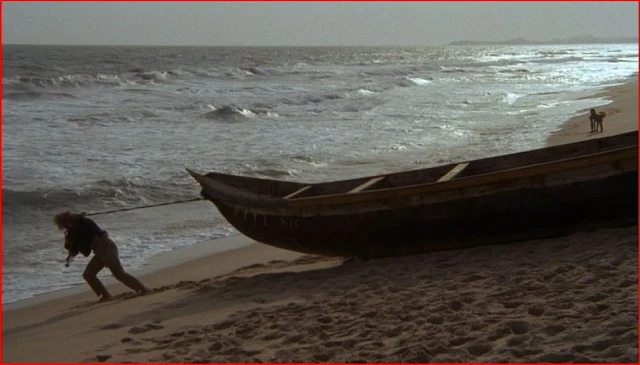 |
| Klaus Kinski in Cobra Verde |
Taparica: King Ampaw
Don Octavio Coutinho: José Lewgoy
Captain Fraternidade: Salvatore Basile
Bernabé: Peter Berling
Euclides: Guillermo Coronel
Bossa Ahadee: Nana Agyefi Kwame II
Director: Werner Herzog
Screenplay: Werner Herzog
Based on a novel by Bruce Chatwin
Cinematography: Viktor Ruzicka
Music: Popol Vuh
With Aguirre, the Wrath of God (1972) and Fitzcarraldo (1982), Cobra Verde constitutes the third element in a trilogy about the insanity of colonialism written and directed by Werner Herzog and starring Klaus Kinski. It's the weakest of the three films, though it's the only one based on a previously published work, Bruce Chatwin's 1980 novel The Viceroy of Ouidah. Its weakness may even stem from having a source: With an existing narrative to work from, Herzog may have been constrained to follow its outline, instead of giving free rein to his usual improvisatory imagination. The film really begins about a third of the way in, after Herzog has loosely established his protagonist's background as a failed rancher, Francisco Manoel da Silva, who has turned outlaw, the "Cobra Verde" of the title. Eventually his charismatic lawlessness leads him to a job as overseer on a Brazilian plantation where, after having impregnated the owner's three daughters, he gets sent on an errand to buy slaves in West Africa -- a task that his employers figure is a win-win situation: either they get rid of a troublesome person or they profit from his success as a slaver. The problem with the first third of the film is that it is told in rather enigmatic sequences, one including a conversation with a philosophical dwarf who owns a bar -- a scene long on talk and short on significance. But the African scenes are often powerful and colorful; Herzog doesn't yield to the impulse to preach about the slave trade, but we see its evil infect everyone, not only da Silva but also the Africans who have been corrupted by participating in it. Some of the big scenes don't quite fit: da Silva spends a long time training an army of women to depose the local chieftain, but his efforts end anticlimactically when the ruler, seated in a courtyard decorated with the skulls of his enemies, folds without a fight. In the end, da Silva is defeated by the decision of the Portuguese to end the slave trade, leaving him penniless and without purpose in a hostile land. In the powerful last scene, da Silva desperately tries to haul a boat, single-handedly, into the crashing surf, only to wind up rolling in the waves. The only witness to his futile efforts is a cruelly deformed man, whose lower body has been so weakened by what we can assume must have been polio, that he walks on all fours, mostly using his hands. It's a horrifying image that tacitly makes its thematic point about the consequences of imperialism.
